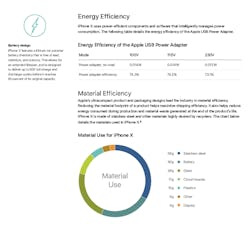Apple makes much of its commitment to responsible sourcing, going so far as to enunciate a supplier code of conduct that spells out the health and safety, labor and human rights, and environmental standards to which it holds third-party vendors. Suppliers are regularly assessed to gauge their performance in each of these three areas, with the goal of improving the overall sustainability of the company's supply chain operations.
To some, Apple is a leader in sustainable sourcing, particularly for its commitment to power its facilities with renewable energy and prod its suppliers to do likewise. Greenpeace has ranked Apple above all other "digital platform" operators in its clean-energy scorecard for the third year in a row, praising the company for playing a "catalytic role within its IT supply chain, pushing other IT data center and cloud operators who help deliver pieces of Apple’s corner of the internet to follow their lead in powering their operations with renewable energy." Detractors, however, contend that many of the company's products, including its flagship iPhone, are intentionally made to be difficult to repair—exercises in planned obsolescence that are designed to ensure customers line up en masse for each new version.
Apple's newest device, the iPhone X, will launch October 27, scarcely a month after the release of the less-heralded iPhone 8. The company has released the iPhone X's environmental report in advance, detailing the new model's performance as it relates to climate change/clean energy, material efficiency, and restricted substances. Here are some of the highlights:
1. Use of Renewable Energy Cuts Greenhouse Gas Emissions
Apple’s supplier clean-energy program, launched in October 2015, aims to reduce the carbon footprint of manufacturing operations by enlisting commitments from vendors to transition to 100% renewable energy for all Apple-related production. To date, 14 suppliers have made that commitment. Apple has further installed 485 megawatts of wind and solar projects across six provinces of China to address upstream emissions that are beyond the influence of its direct suppliers.
Supplier renewable energy projects resulted in a 6% decrease in greenhouse gas emissions related to iPhone X production compared to what they would have been without renewable energy, Apple says. Greenhouse gas emissions vary according to the configuration of iPhone X, with the 64GB emitting 79 kg CO2e, and the 256GB emitting 93 kg CO2e, over their respective lifecycles.
2. Components and Packaging Favor Lower-Carbon-Footprint Materials
Earlier this year, Apple announced the goal of creating a closed-loop supply chain, in which products are built using only renewable resources or recycled material. In the meantime, the company is emphasizing compact device design, specification of materials with high recycled content, and end-of-life recycling.
Apple has swapped out the aluminum enclosure of last year's iPhone 7 for recyclable stainless steel in the iPhone X. And while the device is 36 grams heavier than the iPhone 7, that apparently reflects the larger dimensions and display of the newer model.
The iPhone X's packaging is likewise recyclable, with 100% of the fiber in its retail box sourced either from recycled content, bamboo, waste sugarcane, or "responsibly managed" forests; U.S. retail packaging of the phone contains 55% recycled content. Through the reduction of plastics, Apple says greenhouse gas emissions associated with the packaging of the iPhone X are 56% lower than those of the iPhone 6.
Apple says it participates in product takeback and recycling programs in "99% of the countries" in which its products are sold, including at all Apple stores. All recycled materials are processed in the country or region in which they are collected.
3. Restricted Substances Culled from the Supply Chain
Apple carries out annual chemical mapping at all final assembly sites—reviewing substance locations, storage, and quantities, as well as ventilation and protective equipment—to verify that process chemicals are free of restricted substances such as benzene, n-hexane, and chlorinated organic solvents in cleaners and degreasers. In 2016, the company extended its chemical management efforts to critical component manufacturing suppliers, investigating vendor facilities to assess chemical inventories, occupational hazard risks, and storage and management systems.
The iPhone X similarly avoids the use of toxic materials. Apple says its environmental standards for the iPhone X exceed the dictates of the European RoHS Directive—which restricts the use of potentially hazardous materials such as hexavalent chromium, among others—by specifying an arsenic- and mercury-free display glass and avoiding the use of brominated flame retardant, PVC, and beryllium. The iPhone X battery relies on a lithium-ion polymer chemistry that is free of lead, cadmium, and mercury.










